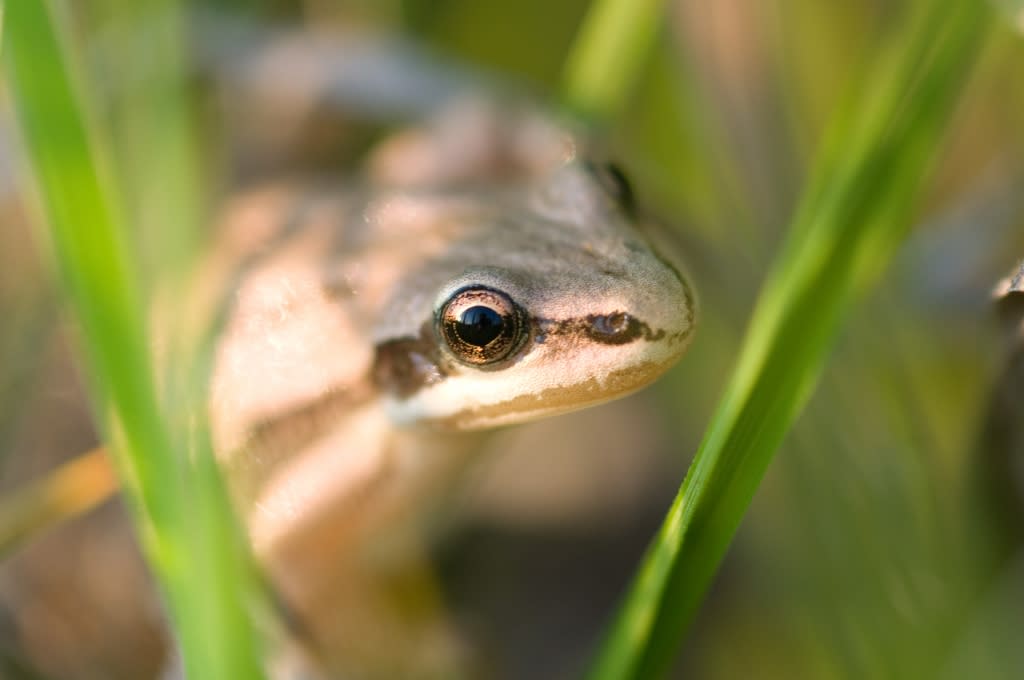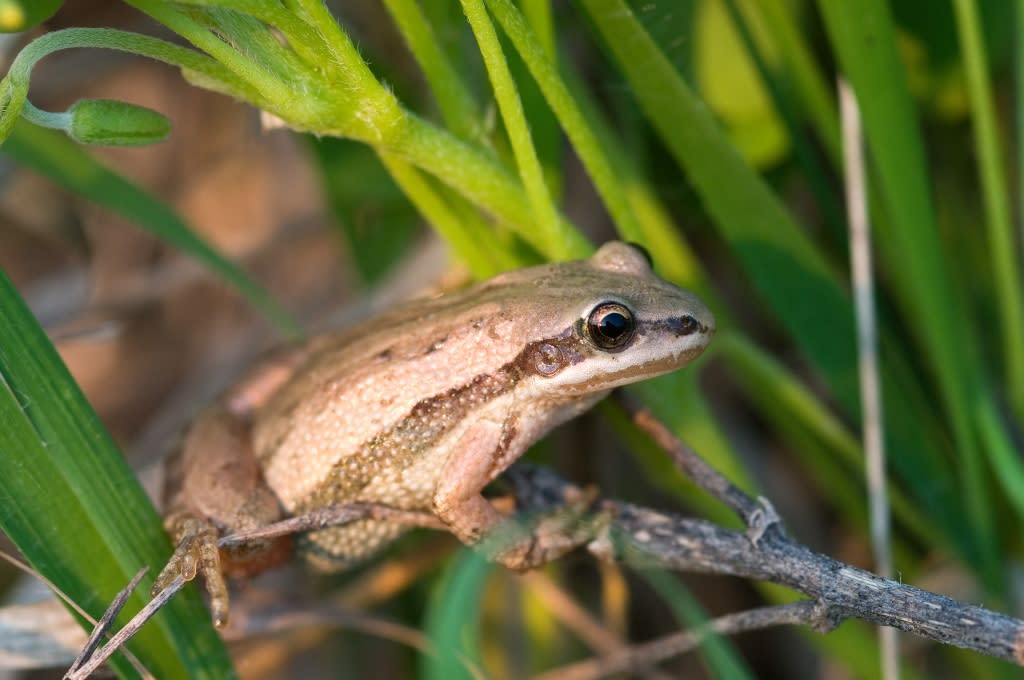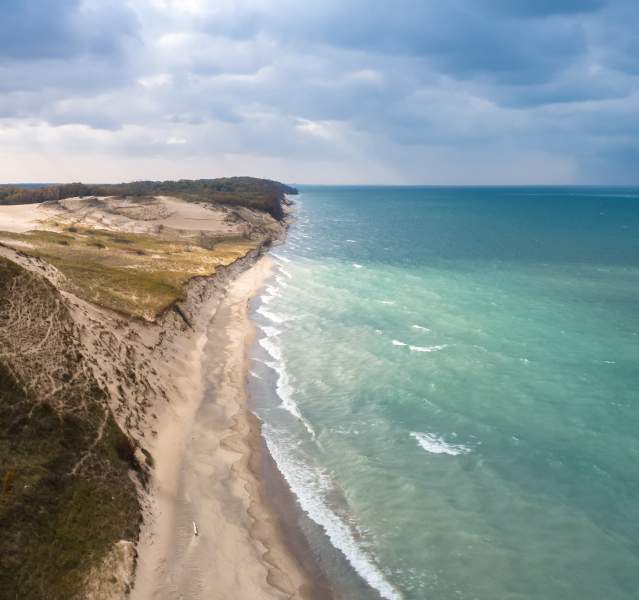While the March prairies are still sleeping and the woodlands are just beginning to break bud, our Indiana wetlands are waking up.
Wetlands are critical habitat for so many plant and animal species. One of our first Indiana wetland residents to begin filling the spring air with its call is the western chorus frog (Pseudacris triseriata). But before they begin calling, chorus frogs not only need to wake up…they need to first defrost! They are one of several frog species* in Indiana that is considered freeze-tolerant, in which their heart stops completely, and up to 70% of the water in their body is frozen! Also known as striped chorus frogs or midland chorus frogs, they spend the winter months hibernating under logs, leaves, or underground in this semi-frozen state.
 Chorus frog in Griffith Prairie north of Aurora, Nebraska. | Photo by: ©Chris Helzer/TNC
Chorus frog in Griffith Prairie north of Aurora, Nebraska. | Photo by: ©Chris Helzer/TNC
As early as February, when the temperature hits that magic number of forty degrees, a lone chorus frog can often be heard. As the temperatures continue to rise in the days that follow, hundreds upon hundreds of chorus frogs will be calling, just like…a chorus! When these armies of frogs really get to calling, it can be so loud that you must shout to your friend in order to be heard.
Chorus frogs are large in voice but small in size. Smaller chorus frogs can be the size of a penny and weigh only as much as a nickel. Some of the largest chorus frogs can be the size of a Kennedy half dollar and weigh as much as three nickels.
Though they only weigh small change, their call is priceless—a melodic rising trill that you can easily replicate by running your finger along the teeth of a comb. Run your finger more slowly over the comb's teeth to replicate a chorus frog calling in cool 40-degree temperatures, and rapidly run your finger over the comb's teeth to simulate the sound of a chorus frog on a warm 60-degree evening. The Indiana DNR website has a good recording of the chorus frog’s call at in.gov/dnr/fish-and-wildlife.
 Chorus frog in Griffith Prairie north of Aurora, Nebraska. | Photo by: ©Chris Helzer/TNC
Chorus frog in Griffith Prairie north of Aurora, Nebraska. | Photo by: ©Chris Helzer/TNC
It’s the male chorus frogs that do the calling, and they are calling to locate a mate. If successful, the females will lay hundreds of clear gelatinous eggs on sticks and vegetation, serving as anchors for the developing eggs, while the male is on her back fertilizing each egg as it is laid. Water temperature determines the length of time it will take the eggs to hatch; the warmer the water, the quicker the development of the egg, which can vary from just a few days to two weeks. Once the eggs hatch, it will take just three months for a tadpole to go from a squiggly swimmer to a mature hopping adult.
Without a doubt, you’ll hear more chorus frogs than you’ll ever see. Their voices are strong and carry far on the water. But should you happen upon a small grey, grey-green, or slate-colored chorus frog, you’ll notice a long dark stripe on each side of its body that originates at its snout, runs through the eye, and along its side. On its back it will have three dark stripes; sometimes the stripes are solid, other times they have a broken pattern. Check out the toes too—they will not have webbing between them.
 Chorus frog in Griffith Prairie north of Aurora, Nebraska. | Photo by: ©Chris Helzer/TNC
Chorus frog in Griffith Prairie north of Aurora, Nebraska. | Photo by: ©Chris Helzer/TNC
When it comes to habitat, the chorus frog is not a specialist, but rather a generalist. You’ll find them in moist meadows, wetlands, marshes, swamps, ditches, temporary ponds, agricultural fields, and even urban environments—anywhere the water is clean and where they can find small insects, spiders, snails, and worms to eat. (Chorus frogs also dine on mosquito larvae! Have you thanked a chorus frog today?)
And just as chorus frogs eat, they also get eaten. Tadpoles are eaten by fish, salamander larva, turtles, birds, and other frogs. Adults can fall prey to water birds, hawks, owls, raccoons, mink, skunks, and larger frogs.
If you’re in the mood to be serenaded by the chorus frogs, it doesn’t take much trying. Just get to a waterway in the evening during the spring and early summer and more than likely, if the water is clean, you’ll hear them. The best types of weather for hearing frogs are rainy, drizzly, foggy, and high-humidity nights.
My family and I have enjoyed driving the roadsides of Kankakee Sands listening to frogs in the evenings as part of frog surveys. We collect the data on the species that we heard and submit the information as part of a community science program called Frog Watch. It’s a very fun, educational, and helpful project. You can find out more at aza.org/frogwatch.
If you want an adventure, come explore a wetland at Kankakee Sands to see and hear the chorus frogs in surround sound. Warning: in healthy wetlands, the calls can be deliciously deafening!
A few tips for a successful wetland exploration and frog romp:
- Wear old clothes and old shoes, lots of layers on your upper half, and a hat to keep that noggin warm.
- Pack a fresh, dry set of everything, including undergarments, socks, and shoes for the return trip home. That way you can fully explore (i.e. fall down) and still be reassured that the trip home will be a pleasant one.
- Bring a friend (and be sure they have their change of clothes, too)!
- Secure that phone! Many a phone have been lost on the prairies and wetlands of Kankakee Sands, unfortunately.
- For the wetland explorers, simply zipping your phone into a plastic bag and tucking it in your pocket will help keep your phone dry should you go a little deeper than expected (i.e. fall down). You can still use the phone through the plastic, though pictures will be fuzzy.
Get on out to a wetland or waterway near you this spring for some frog fun. The chorus frogs will be calling spring, and sure enough, spring will come!
*Other freeze-tolerant frogs in Indiana include wood frogs, Cope’s gray tree frogs, eastern gray tree frogs, spring peepers, and western chorus frogs.
The Nature Conservancy’s Kankakee Sands is an 8,300-acre prairie and savanna habitat in Northwest Indiana, open every day of the year for public enjoyment. For more information about Kankakee Sands, visit nature.org/KankakeeSands or call the office at 219-285-2184.

